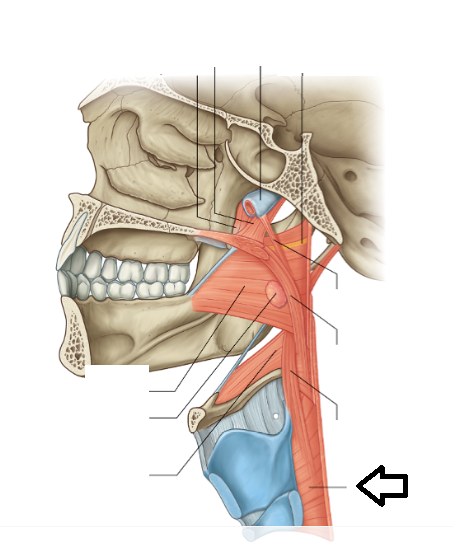

The cricopharyngeus muscle originates from the lowest portion of the inferior constrictor muscle and acts as a sphincter at the inferior terminus of the pharynx. It inserts into the pharyngeal raphe and propels bolus downward. The inferior constrictor muscle originates from the lamina of the thyroid cartilage and the cricoid cartilage of the larynx. It inserts into the pharyngeal raphe and serves to propel bolus downward. The middle constrictor muscle originates from the inferior portion of the stylohyoid ligament and the lesser and greater cornua of the hyoid bone. It aids in the closure of the soft palate during swallowing and most importantly is that it propels bolus toward downward. It inserts into the pharyngeal tubercle of the occipital bone and the pharyngeal raphe (midline fibers) posteriorly. The superior constrictor muscle originates from the medial pterygoid plate, pterygoid hamulus, pterygomandibular ligament and mylohyoid line of the mandible. The musculature of the pharynx is extremely crucial for the pharynx to fulfill its various normal and necessary functions. Muscles of the pharynx, as has been noted earlier, can be described as four constrictor muscles (superior, middle, inferior and cricopharyngeus) and three muscles of the longitudinal group (stylopharyngeus, palatopharyngeus, and salpingopharyngeus). Inferiorly, the ring forms by the lingual tonsils on the posterior surface of the tongue. The palatine tonsils and tubal tonsils (around the auditory tubes) form the lateral wall of the ring. It is formed superiorly by the pharyngeal tonsils, also known as adenoids, in the roof of the nasal pharynx. This ring protects the entrance of the GIT and the respiratory tract. There is a ring of lymphoid tissue that is formed by four lymph groups, referred to as the Waldeyer ring. The deep cervical lymph nodes are the groups of lymph nodes located along the course of the internal jaguar vein or indirect drainage toward the deep cervical lymph nodes via the retropharyngeal lymph nodes (located behind the pharynx) or paratracheal lymph nodes (alongside the course of the trachea). Venous drainage is formed by the pharyngeal veins which drain the pharynx into the internal jugular vein. The lymphatic drainage of the pharynx is direct drainage, which means that lymph passes directly toward the deep cervical lymph nodes (DCLNs). įour arteries from each external carotid artery supply the pharynx with oxygen-rich blood which is the ascending pharyngeal, tonsilar (a branch of the facial artery), maxillary and lingual arteries. Air passes from the upper two parts of the pharynx (nasal and oral) and enters the laryngeal pharynx toward the inlet of the larynx and from there to trachea down the respiratory tract. Simultaneously, the epiglottis (single cartilage at the upper part of the larynx) is pushed anteriorly to close the laryngeal inlet preventing food from entering the airways. Lastly, the laryngeal pharynx receives bolus from the oral pharynx and passes it into the esophagus for digestion. These tubes are connected to the middle ears (tympanic cavities) posteriorly and mainly serve to equalize pressure and facilitate the drainage of the secretions of the middle ears. Second, the oral pharynx is a continuation of the oral cavity and functions to pass the bolus toward the laryngeal pharynx below.Īs the bolus passes from the oral cavity, the muscles of the soft palate contract to close the choanae so that food does not enter the nasal cavity. Also, within the lateral surface of the back of the nasopharynx, there are two openings, one on either side, which is called the auditory tubes (Eustachian tubes or pharyngotympanic tubes) surrounded by elevations of mucous membrane called tubal elevations. Regionally, the pharynx divides into three parts which are from superior to inferior:-the nasal pharynx, located behind the posterior nasal apertures (choanae), the oral pharynx, located behind the opening of the oral cavity, and the laryngeal pharynx, located behind the inlet (opening) of the larynx. First, the nasal pharynx is only related to the respiratory tract as air passes through it from the nasal cavities.


 0 kommentar(er)
0 kommentar(er)
